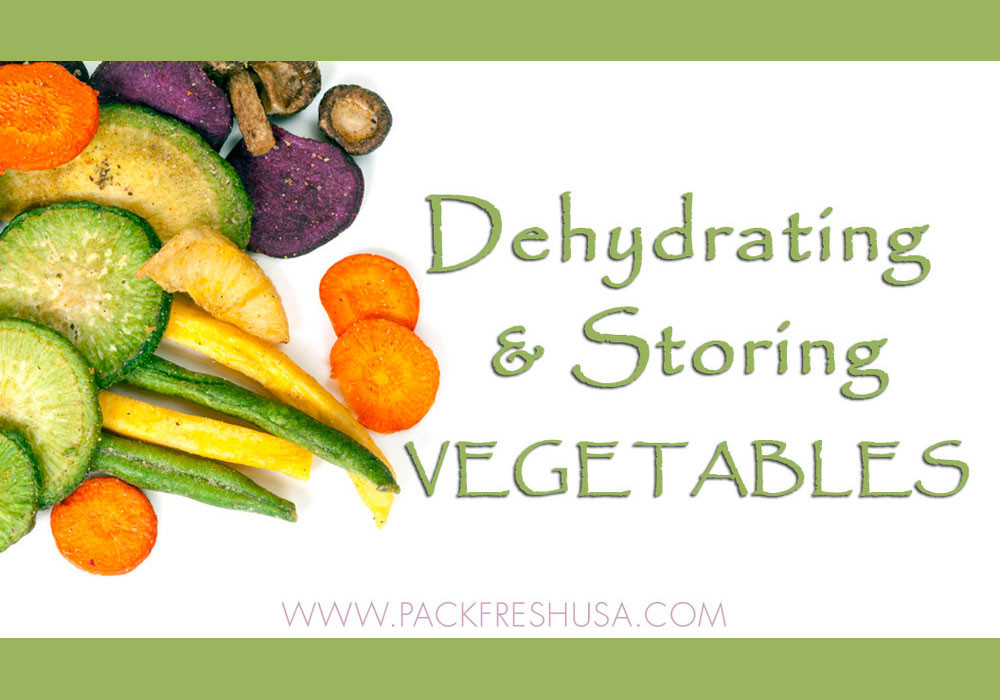Dehydrating & Storing Vegetables
Posted by PackFreshUSA on Oct 10th 2018
Dehydrating
vegetables is a great way to save your harvest and/or save money when
your local grocery store offers deals you just can’t pass up; $7.99 for
25 lbs. of carrots?! Yes, Please! Don't forget you can also dehydrate
frozen vegetables.
Aside from having your own stock of vegetables all year around, dried
vegetables can be stored for well over 25 years when storing them in
Mylar bags and oxygen absorbers. Dehydrated vegetables have a unique
flavor and texture and are best used as ingredients for soups, stews,
casseroles, and sauces rather than stand-alone side dishes.
When drying smaller vegetables, such as
peas or carrots, it is recommended that you use a mesh screen, this will
prevent smaller foods from falling through the grates in the tray as
they dehydrate.
Wash vegetables to remove dirt and debris. Trim vegetables to remove
fibrous or woody portions or bruise and decayed areas, peel and slice
using the preparation guide below.
Pretreatment:
The process of blanching involves
subjecting vegetables to a high enough temperature to deactivate the
enzymes. Blanching is necessary to stop the naturally occurring enzymes
from causing loss of color and flavor during drying and storage.
Blanching also relaxes the tissue walls so moisture can more readily
escape during drying and enter during rehydrating. Blanching can be done
in water or steam. Water blanching causes a greater loss of nutrients
but is faster than steam blanching and achieves a more even heat
penetration.
Stem Blanching: Fill a deep pot with water and
bring to a boil. Place vegetables loosely in a basket or colander that
will allow steam to freely circulate around the vegetables. Do not fill
basket or colander with more than a 2 ½ - inch later of vegetables.
Position the basket or colander in the pot, making sure it does not
contact the boiling water. Cover with a close-fitting lid. Steam for the
time indicated in the preparation guide below.
Water Blanching: Fill a large pot 2/3 full with
water. Cover and bring to a boil. Place vegetables loosely in a basket
or colander and submerge in the boiling water. Cover and blanch for the
time indicated in the guide below. Water should return to a boil in less
than 1 minute. If not, too many vegetables were added to the basket;
reduce amount. Water blanch for the time indicated in the dying guide
below.
Immediately after steam or water blanching, dip the vegetables in cold
water to quickly cool them. Drain the vegetables and arrange them in a
single layer on the dehydrator trays.
Note: Don't have a dehydrator? Using your oven to dehydrate will also work!
Determining Dryness :
Vegetables do dry much faster than fruits. At the end of dehydrating period moisture loss is rapid. As a result, vegetables need to be checked often towards the end of the drying time to prevent over drying. Food turns brown when it is overdried.
Begin checking the vegetables at the beginning of the average drying time range. Remove a few pieces and allow to cool to room temperature. Test for dryness by breaking the pieces in half; most vegetables will be crisp when appropriately dried and will break easily.
Storage:
Dried vegetables need to be properly
packaged to prevent reabsorption of moisture and microbial
deterioration. Pack food in clean, dry, airtight containers. Store
packaged dried fruit in a dry, cool location away from light.
Before packing your vegetables in Mylar bags for long term food storage, pack them in mason jars with the appropriate size
desiccant to remove any excess moisture that may have been left behind. After 24
to 48 hours, you can store in Mylar bags or keep in the mason jars with
an oxygen absorber to maintain freshness. Dried vegetables can be stored
in Mylar bags for well over 25 years if used with oxygen absorbers.
Start dehydrating and preserving your vegetables!
Desiccants
Oxygen absorbers
Mylar Bags
Click HERE to learn how to dehydrate fruits.
Have questions about dehydrating or long term food storage?
Give us a call at (844)857-8277 or email us at customerservice@packfreshusa.com

